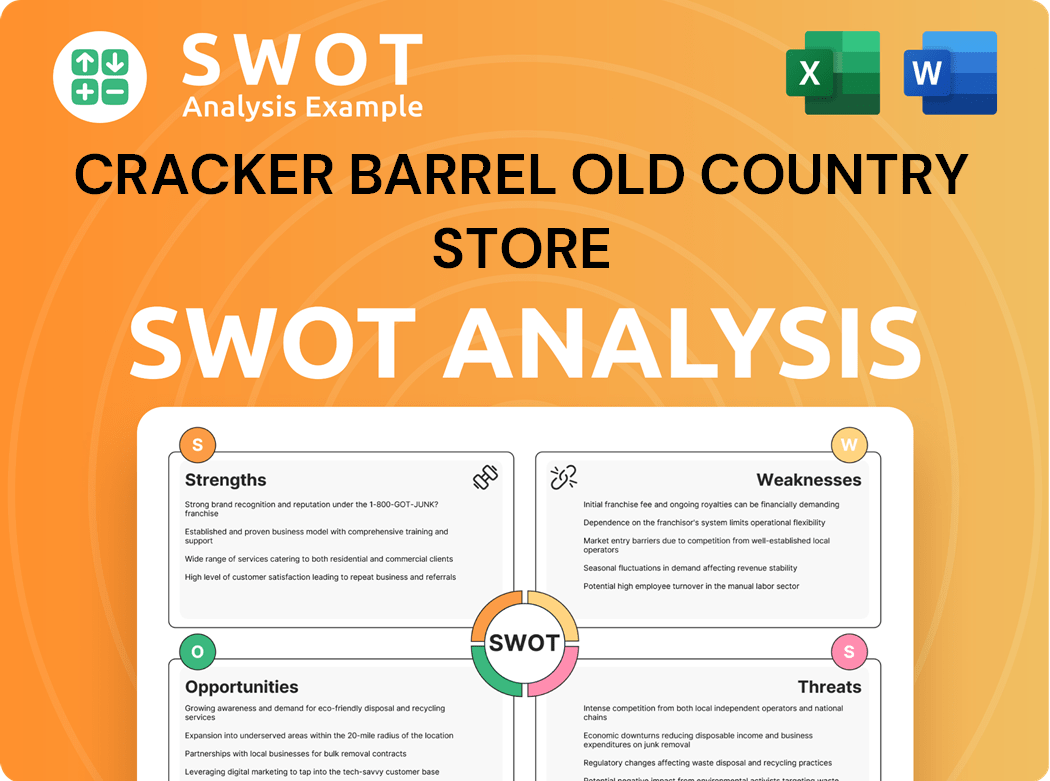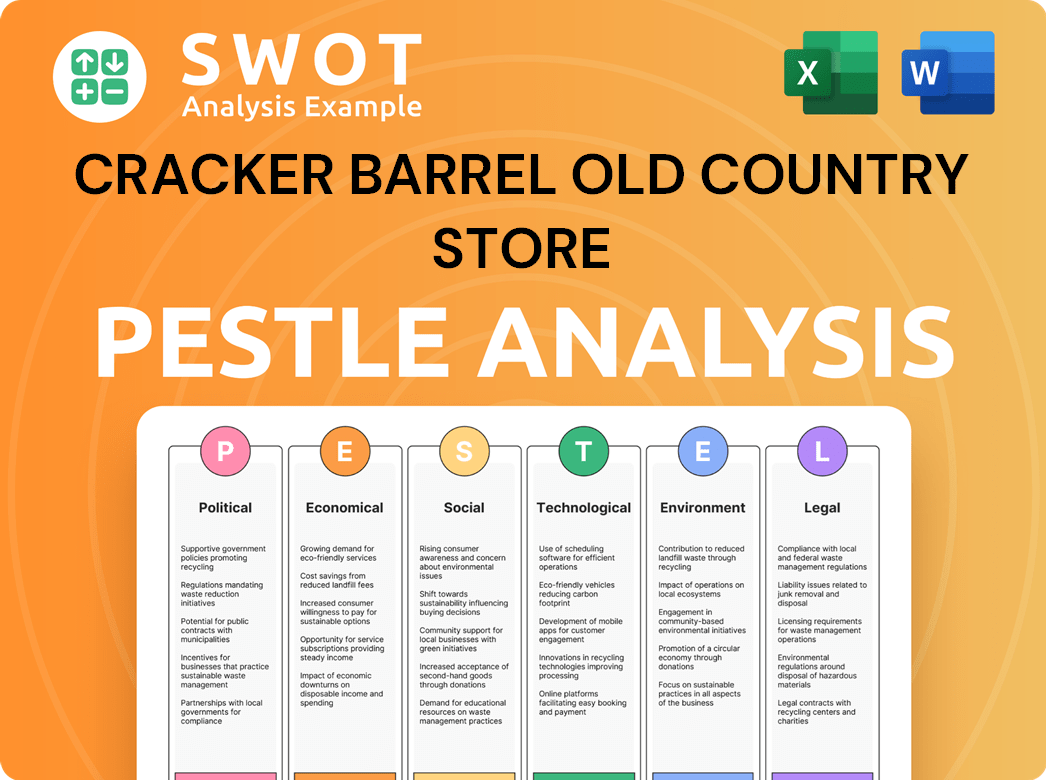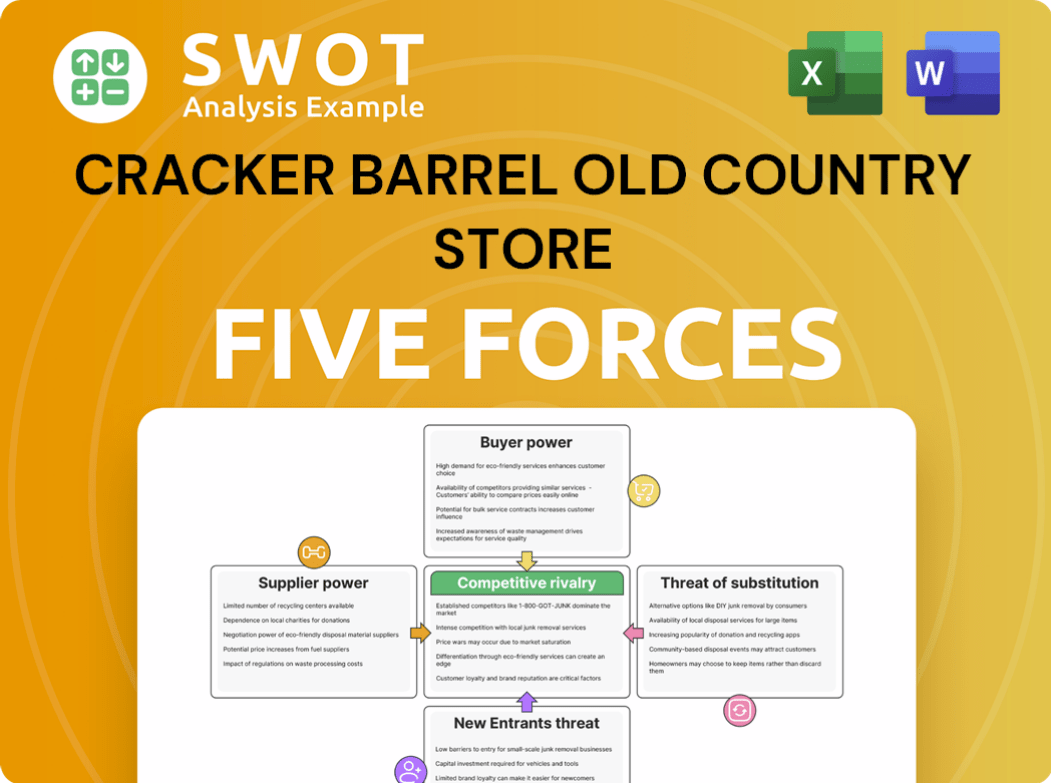Cracker Barrel Old Country Store Bundle
How Does Cracker Barrel Thrive in a Crowded Market?
Cracker Barrel Old Country Store has long been a staple for travelers and families seeking comfort food and a unique shopping experience. But how does this iconic brand fare against the ever-changing tides of the Cracker Barrel Old Country Store SWOT Analysis? This analysis delves into the company's competitive landscape, exploring its strengths, weaknesses, and strategic positioning within the restaurant and retail industries. Understanding Cracker Barrel's market dynamics is crucial for anyone looking to invest, analyze, or strategize in the food service sector.

The Cracker Barrel competitive landscape is a complex arena, with the company facing challenges from both the restaurant industry competition and the retail sector. This examination will identify Cracker Barrel competitors, analyze their strategies, and assess Cracker Barrel market analysis to provide a comprehensive understanding of its position. Furthermore, we'll explore how Cracker Barrel adapts to changing consumer preferences and navigates the casual dining rivals environment to maintain its market share.
Where Does Cracker Barrel Old Country Store’ Stand in the Current Market?
Cracker Barrel Old Country Store's market position is defined by its unique blend of casual dining and retail operations. This dual approach allows it to cater to a broad customer base seeking both a meal and a shopping experience. For the fiscal year ending July 28, 2023, the company generated approximately $3.4 billion in total revenue, demonstrating its significant presence in the industry.
The company's core value proposition centers on offering a nostalgic, homestyle experience, appealing to families and travelers. Its menu features Southern-inspired comfort food, complemented by a retail selection of country-themed merchandise. With over 660 locations across 45 states, Cracker Barrel has established a strong national footprint, particularly in areas with high interstate travel.
Cracker Barrel's consistent revenue generation underscores its established position in the market. Its financial health, as indicated by its revenue, suggests stability. However, the company faces challenges in adapting to evolving consumer preferences and intense competition in both the restaurant and retail sectors.
Cracker Barrel's market presence is substantial, with over 660 locations across 45 states. This extensive network allows it to reach a wide customer base. The company's revenue of around $3.4 billion in fiscal year 2023 reflects its significant scale within the casual dining and retail sectors.
The primary target audience includes families and travelers seeking a nostalgic dining experience. Cracker Barrel appeals to those looking for homestyle comfort food and unique country-themed merchandise. Its locations are often strategically placed to capture interstate travelers.
Cracker Barrel's unique model, combining a restaurant and gift store, offers a competitive advantage. This dual-segment operation differentiates it from competitors focused solely on dining or retail. The company's consistent revenue generation is a testament to its strong market position.
Adapting to changing consumer preferences and intense competition in both the restaurant and retail segments poses challenges. Cracker Barrel must innovate its menu and offerings to maintain its appeal. The company's strategies include modernizing its offerings while preserving its traditional appeal.
Cracker Barrel operates within a competitive landscape that includes both the restaurant and retail industries. Its main competitors in the restaurant industry include other family-style dining establishments. The company's ability to maintain its market position hinges on its ability to adapt and innovate.
- The company's financial performance, including its revenue of $3.4 billion in fiscal year 2023, is a key indicator of its market position.
- Cracker Barrel's menu innovations and customer loyalty programs are critical for maintaining its competitive edge.
- Understanding the Revenue Streams & Business Model of Cracker Barrel Old Country Store is crucial for assessing its long-term viability.
- The company's response to changing consumer preferences and its digital presence are vital for future success.
Cracker Barrel Old Country Store SWOT Analysis
- Complete SWOT Breakdown
- Fully Customizable
- Editable in Excel & Word
- Professional Formatting
- Investor-Ready Format

Who Are the Main Competitors Challenging Cracker Barrel Old Country Store?
The Cracker Barrel competitive landscape is shaped by its dual business model, encompassing both restaurant and retail operations. This structure means it faces a wide array of competitors. Understanding these rivals is crucial for a thorough Cracker Barrel market analysis, as it informs strategic decisions about pricing, menu development, and marketing.
The company's success hinges on its ability to differentiate itself in a crowded marketplace. The restaurant industry competition is fierce, and Cracker Barrel must constantly adapt to maintain its market position. This requires a deep understanding of its casual dining rivals and their strategies.
Direct competitors in the casual dining space include Bob Evans Restaurants, which shares a similar family-friendly, homestyle dining experience. Denny's and IHOP also compete for the family dining market. These rivals challenge Cracker Barrel with competitive pricing and diverse menu offerings.
Cracker Barrel's retail segment competes with specialty retail stores, souvenir shops, and general merchandise retailers like Walmart and Target. Online retailers, such as Amazon, also pose a threat. Emerging retailers focusing on unique or locally sourced goods present additional competition.
Competitors are investing in digital ordering, delivery services, and updated restaurant designs. Cracker Barrel needs to balance its nostalgic appeal with modern conveniences. Mergers and alliances in both restaurant and retail industries shift competitive dynamics.
Analyzing Cracker Barrel's strengths and weaknesses compared to rivals is essential. Understanding the market share of Cracker Barrel vs. other family restaurants helps in assessing its position. The company's financial performance relative to its rivals is a key indicator.
The impact of inflation and changing consumer preferences significantly affect the competitive landscape. Cracker Barrel's expansion strategies and competitive threats are influenced by these factors. Consumer trends also impact Cracker Barrel's menu innovation and competitive positioning.
Cracker Barrel's online presence and digital competition are increasingly important. Customer loyalty programs of Cracker Barrel and its rivals play a crucial role. The company's ability to adapt to these changes is vital.
Several factors determine Cracker Barrel's success in the competitive landscape. These include menu innovation, customer service, and effective marketing. Understanding how does Cracker Barrel compare to IHOP in terms of sales and other metrics is important.
- Menu Innovation: Cracker Barrel needs to regularly update its menu to stay relevant.
- Customer Service: Providing excellent service is crucial for customer loyalty.
- Marketing: Effective marketing helps attract and retain customers.
- Pricing Strategy: Competitive pricing is essential to attract customers.
- Location Strategy: Prime locations influence foot traffic.
For more insights into the company’s financial performance, consider reading about Owners & Shareholders of Cracker Barrel Old Country Store.
Cracker Barrel Old Country Store PESTLE Analysis
- Covers All 6 PESTLE Categories
- No Research Needed – Save Hours of Work
- Built by Experts, Trusted by Consultants
- Instant Download, Ready to Use
- 100% Editable, Fully Customizable

What Gives Cracker Barrel Old Country Store a Competitive Edge Over Its Rivals?
The competitive landscape for Cracker Barrel Old Country Store is shaped by its unique positioning in the restaurant industry competition. Cracker Barrel's primary competitive advantage stems from its integrated restaurant and retail model, which creates a distinctive customer experience. This strategy allows it to capture a larger share of customer spending compared to standalone restaurants or retail stores. Understanding the dynamics of Cracker Barrel's market analysis is crucial for assessing its performance against rivals.
Cracker Barrel's ability to maintain a strong brand identity and customer loyalty is another key factor. The company's nostalgic 'Old Country Store' theme and focus on homestyle cuisine appeal to a specific customer segment, creating a loyal customer base. The company's operational efficiencies and economies of scale, resulting from its national footprint, contribute to its competitive edge. This allows for efficient procurement and distribution, supporting both its food and retail offerings.
Cracker Barrel's success also hinges on its ability to adapt to changing consumer preferences and market trends. The company must navigate the evolving food service market share landscape and address challenges such as shifting consumer tastes towards healthier options and the growth of e-commerce. The company's strategies to compete in the restaurant industry, including menu innovation and digital presence, are essential for maintaining its competitive position. To learn more about its growth strategies, consider reading about the Growth Strategy of Cracker Barrel Old Country Store.
Cracker Barrel combines a restaurant and retail store under one roof, offering a unique customer experience. This integrated model encourages longer customer visits and multiple revenue streams. This approach differentiates it from competitors and contributes to its financial performance.
The 'Old Country Store' theme and focus on homestyle cuisine create a strong brand identity. This nostalgic theme appeals to families and travelers, fostering customer loyalty. Its consistent food quality and service further enhance customer loyalty.
With over 660 locations, Cracker Barrel benefits from economies of scale in its supply chain and operations. This allows for efficient procurement and distribution of both food and retail merchandise. The national footprint supports consistent quality and cost management.
Cracker Barrel's focus on homestyle, Southern-inspired cuisine differentiates it from competitors. This niche culinary focus appeals to a specific customer segment that values traditional comfort food. The consistent food quality helps build a loyal customer base.
Cracker Barrel's competitive advantages include its unique business model, strong brand identity, and operational efficiencies. These factors enable Cracker Barrel to maintain a strong position in the casual dining market. The company's ability to adapt to changing consumer preferences is crucial for its long-term success.
- Integrated Restaurant and Retail: Combines dining and retail, increasing revenue per customer.
- Strong Brand and Customer Loyalty: The 'Old Country Store' theme and consistent quality foster loyalty.
- Operational Efficiencies: Economies of scale from a large national footprint.
- Focus on Homestyle Cuisine: Appeals to a specific customer segment.
Cracker Barrel Old Country Store Business Model Canvas
- Complete 9-Block Business Model Canvas
- Effortlessly Communicate Your Business Strategy
- Investor-Ready BMC Format
- 100% Editable and Customizable
- Clear and Structured Layout

What Industry Trends Are Reshaping Cracker Barrel Old Country Store’s Competitive Landscape?
The competitive landscape for Cracker Barrel Old Country Store is shaped by evolving industry trends, presenting both challenges and opportunities. The restaurant industry faces technological advancements like online ordering and digital loyalty programs. Regulatory changes, particularly concerning labor costs and food safety, also impact operational expenses. Moreover, consumer preferences are shifting towards healthier options and sustainable practices, influencing Cracker Barrel's menu development.
Understanding the Cracker Barrel competitive landscape is crucial for assessing its future prospects. Potential threats include declining demand for traditional casual dining. Increased competition, especially in experiential dining, could also disrupt market share. However, significant growth opportunities exist in digital expansion, menu innovation, and strategic partnerships. Analyzing these factors helps in understanding the Cracker Barrel market analysis and its position within the restaurant industry competition.
The restaurant industry is seeing increased adoption of online ordering and delivery services. Regulatory changes, particularly regarding labor costs and food safety, are also impacting operations. Consumer preferences are shifting towards healthier options and sustainable practices, which influences menu development. These trends significantly affect Cracker Barrel's competitive landscape.
Declining demand for traditional casual dining experiences poses a threat. Increased competition from new entrants, especially in experiential dining, could disrupt market share. Furthermore, adapting to changing consumer preferences and maintaining appeal are ongoing challenges. These challenges require strategic responses within the food service market share.
Expanding the digital footprint and enhancing e-commerce capabilities could unlock new revenue streams. Menu innovation, including more diverse and health-conscious options, is another avenue. Strategic partnerships and exploring new store formats also present growth opportunities. These strategies are crucial for navigating the casual dining rivals.
Adapting to industry trends requires balancing tradition with innovation. Enhancing digital capabilities and expanding e-commerce are key. Menu innovation and strategic partnerships are also essential. These adaptations are vital for maintaining a competitive edge in the Cracker Barrel competitive landscape.
Cracker Barrel's ability to adapt to changing consumer preferences and market dynamics will determine its success. Expanding digital presence and enhancing e-commerce are vital. Menu innovation and strategic partnerships are also crucial. For a deeper dive into the company's origins, consider reading a Brief History of Cracker Barrel Old Country Store.
- Embracing digital transformation for online ordering and loyalty programs.
- Innovating the menu to include healthier and diverse options.
- Forming strategic partnerships for delivery and brand collaborations.
- Exploring new store formats for geographic expansion.
Cracker Barrel Old Country Store Porter's Five Forces Analysis
- Covers All 5 Competitive Forces in Detail
- Structured for Consultants, Students, and Founders
- 100% Editable in Microsoft Word & Excel
- Instant Digital Download – Use Immediately
- Compatible with Mac & PC – Fully Unlocked

Related Blogs
- What are Mission Vision & Core Values of Cracker Barrel Old Country Store Company?
- What is Growth Strategy and Future Prospects of Cracker Barrel Old Country Store Company?
- How Does Cracker Barrel Old Country Store Company Work?
- What is Sales and Marketing Strategy of Cracker Barrel Old Country Store Company?
- What is Brief History of Cracker Barrel Old Country Store Company?
- Who Owns Cracker Barrel Old Country Store Company?
- What is Customer Demographics and Target Market of Cracker Barrel Old Country Store Company?
Disclaimer
All information, articles, and product details provided on this website are for general informational and educational purposes only. We do not claim any ownership over, nor do we intend to infringe upon, any trademarks, copyrights, logos, brand names, or other intellectual property mentioned or depicted on this site. Such intellectual property remains the property of its respective owners, and any references here are made solely for identification or informational purposes, without implying any affiliation, endorsement, or partnership.
We make no representations or warranties, express or implied, regarding the accuracy, completeness, or suitability of any content or products presented. Nothing on this website should be construed as legal, tax, investment, financial, medical, or other professional advice. In addition, no part of this site—including articles or product references—constitutes a solicitation, recommendation, endorsement, advertisement, or offer to buy or sell any securities, franchises, or other financial instruments, particularly in jurisdictions where such activity would be unlawful.
All content is of a general nature and may not address the specific circumstances of any individual or entity. It is not a substitute for professional advice or services. Any actions you take based on the information provided here are strictly at your own risk. You accept full responsibility for any decisions or outcomes arising from your use of this website and agree to release us from any liability in connection with your use of, or reliance upon, the content or products found herein.